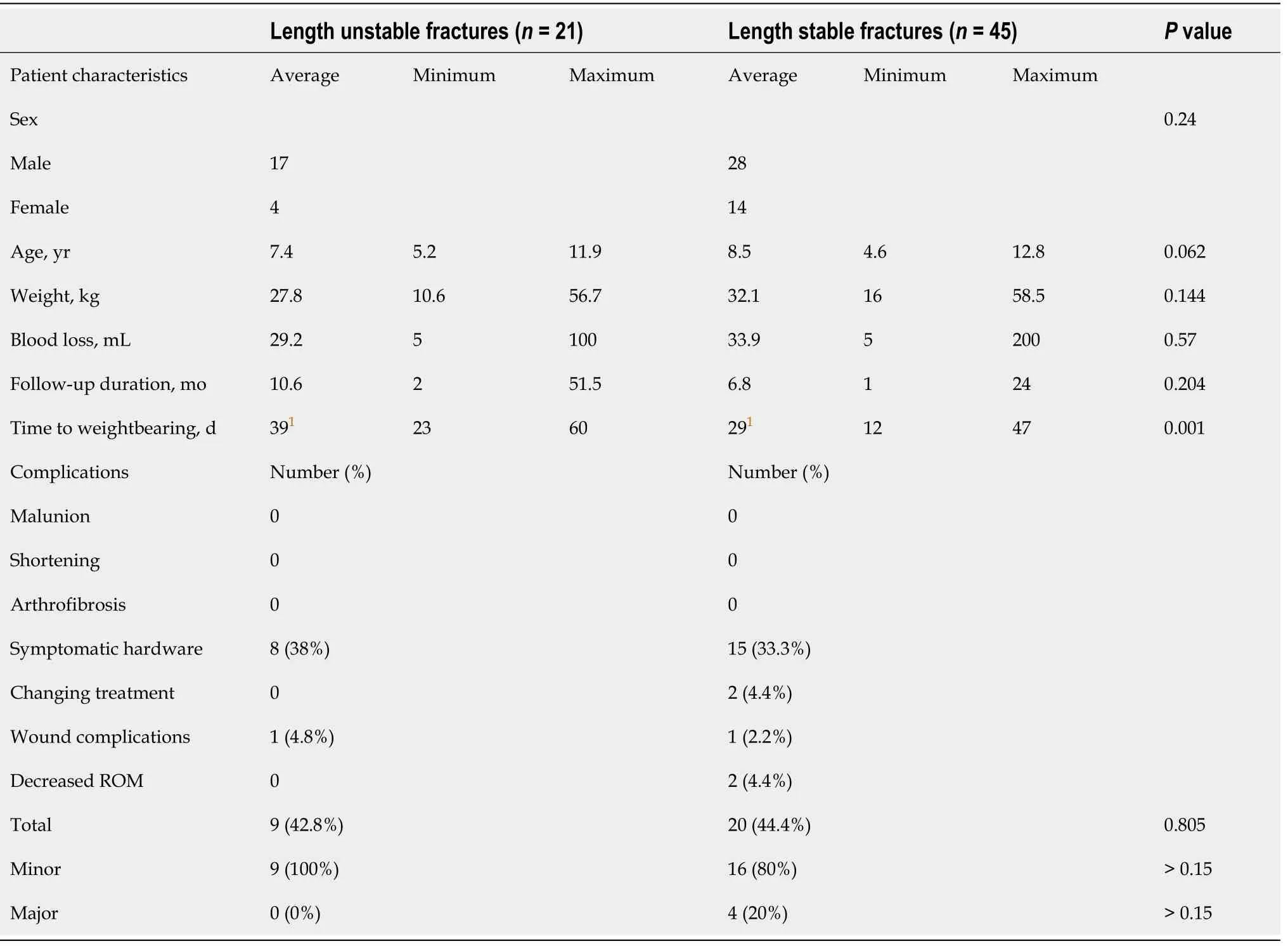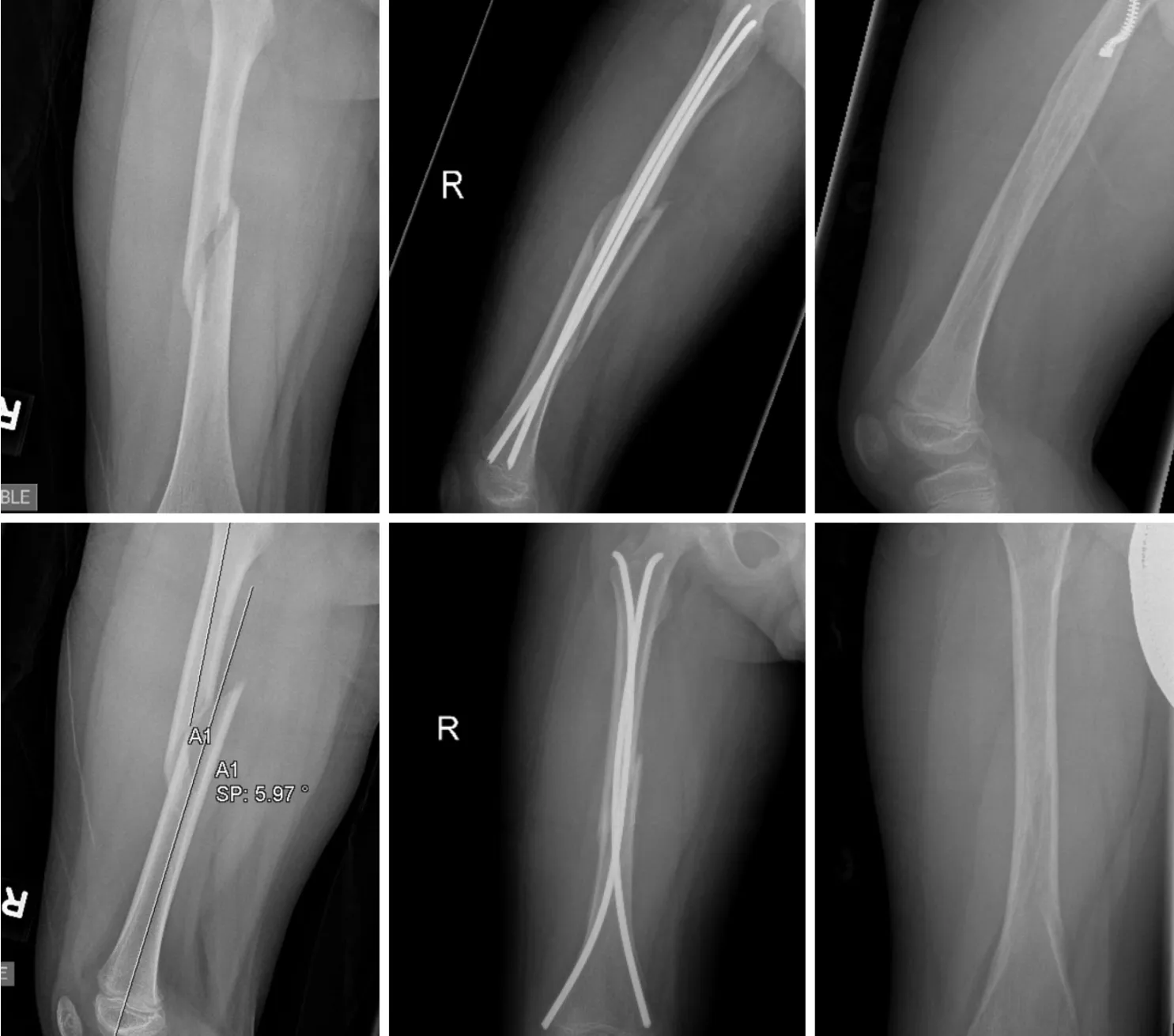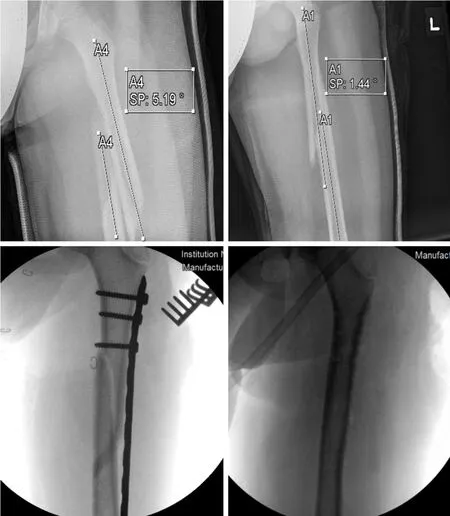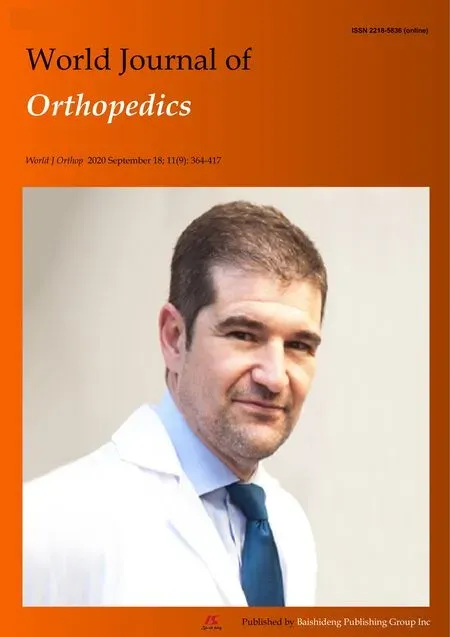Length unstable femoral fractures:A misnomer?
2020-10-26
Abstract
Key Words:Flexible intramedullary nail; Titanium elastic mail; Elastic stable intramedullary nail; Pediatrics; Length unstable; Femoral fractures; Bone fracture;Orthopedics
INTRODUCTION
Diaphyseal femoral fractures account for roughly 1.6% of fractures in pediatric patients 5-18 years of age with an incidence of 19 per 100000 children[1,2]and are more common in males[3].These fractures place a substantial burden on the patient and their family due to hospitalizations,complex treatment options,and lengthy recovery times[2,4].Fracture pattern,length stability,patient weight/age,geographic location,and surgeon preference all play a role in the choice of treatment[1].Surgical intervention is nearly always recommended for pediatric femoral fracture patients above the age of 5[5].
Length unstable fractures have been defined as spiral/long oblique or comminuted,with a fracture line length ≥ twice the diameter of the femoral shaft at the level of the fracture[5-11].This fracture is often associated with > 2 cm of shortening[5,12].The length unstable diaphyseal femoral fracture is problematic in children ages 5–11 due to the long recovery time,skeletal immaturity,heightened risk of post-operative complications,and a lack of consensus as to the proper fixation modality[5,6,13].Options include external fixation (Ex fix),submuscular plating (SMP),open/compression plating,flexible intramedullary nailing (FIMN) (titaniumvsstainless steel) (lockedvsnon-locked),rigid intramedullary nailing,ex fix in combination with elastic nailing,semi-rigid pediatric locking nail,and others[14-16].FIMN of the pediatric femur,which is synonymous with both titanium elastic nailing and elastic stable intramedullary nailing,provides immediate-to-early stability to the involved bone segment,permitting early mobilization and allows for return to normal activities with a relatively low complication rate[17].Although FIMN is an effective procedure for length stable diaphyseal pediatric femoral fractures,there is concern regarding its use for length unstable fractures[8,9,14,18-21].Potential complications with FIMN treatment for length unstable fractures include suboptimal stability leading to angulation,shortening,rotation[8,22-24],and nail protrusion resulting in symptomatic hardware with skin irritation being the primary patient complaint[6,16,25].
Despite the above concerns,FIMN is still often used for length unstable femur fractures.We hypothesized that FIMN is a viable option for length unstable femur fractures with a rate of complications that does not differ unfavorably from other treatment options.We performed a retrospective chart review at a single institution to compare FIMN with other treatment options for length unstable femur fractures with a primary outcome of complications.Also,because the treatment group,length unstable other than FIMN,was slightly older and heavier,we utilized a second comparison group,length stable fractures treated with FIMN.
MATERIALS AND METHODS
Institutional Review Board approval was obtained.Billing databases at a single institution were used to identify patients (age range 5–13) who had received surgical management of a diaphyseal femoral fracture from 2013–2019.Charts and radiographs were reviewed.Recorded data included patient characteristics (sex,age,weight,fracture type,blood loss from surgery,follow-up duration and time to weight bearing)and complications (rotational deformity,shortening,arthrofibrosis,symptomatic hardware,treatment change,wound complications,and decreased range of motion).Complications were stratified into minor and major in accordance with previous studies[26].Minor complications constitute pain at the nail insertion site (i.e.,symptomatic hardware) and temporary complications that are self-resolving or that are completely resolved without surgery (e.g.superficial surgical site infection and superficial wound complications).Major complications are those persisting at final follow-up or those requiring additional procedures and include instrument failure requiring revision,rotational deformities requiring surgical correction,and arthrofibrosis requiring knee manipulation under anesthesia.The only exception to an additional procedure considered as a minor complication is hardware removal due to symptoms.Patients who had an elective hardware removal in the absence of symptoms were not included as complications.Rotational deformity and leg-length discrepancy were assessed clinically by the treating orthopaedist.If a clinical concern of either deformity was raised,then long-leg X-rays with the contralateral leg were obtained.Shortening was measured on lateral X-rays and was defined as shortening greater than 14 mm,which is the upper acceptable limit in the literature[27].
Inclusion criteria is a femur fracture in a patient aged 5-13 years.One hundred and sixty-three such patients were identified.Cases were excluded if they had an underlying predisposition for fractures (e.g.,pathologic fractures or osteogenesis imperfecta) (9 patients),polytrauma necessitating intensive care unit care and/or extensive management of other injuries [may skew data on variables including estimated blood loss (EBL),operative time,and time to weight bearing due to the associated injuries] (12 patients),incomplete records (8 patients),or no follow-up visits(12 patients).Thirty patients were also excluded as they had a length stable fracture treated with modalities other than FIMN.Ninety-two patients with 95 fractures were included.They constituted three groups:Length unstable femoral fractures treated with FIMN,length unstable femoral fractures treated with a modality other than FIMN (locked IMN,SMP,and external fixators),and length stable femoral fractures treated with FIMN.Primary outcomes for the study were the number and percentage of complications per each group and the secondary outcomes included the types of complications per each group (e.g.symptomatic hardware,rotational deformity,etc.)and their severity (major or minor).
A two-tailed t-test and a chi-square test were performed for continuous and categorical data,respectively.Pvalues < 0.05 were considered statistically significant.
Regarding the primary surgical treatment of interest in this study,FIMN,the procedure described in depth by Buschet al[26]is the one predominantly carried out at our institution.Also,patient follow-up was achieved in clinic at our institution from the first presentation of the involved femoral fracture(s) to the patient’s last clinic visit.Our institution also does not typically cast fractures in conjunction with FIMN,and patients included in this study were not casted after surgical correction.The treating orthopaedist considered the fracture(s) completely resolved when union was evident on x-ray and when the patient’s symptoms,specific to the prior femoral fracture(s) of concern,were resolved.All patients were given the option of additional follow-up in clinic if symptoms reemerged and/or if a physical deformity appeared.
RESULTS
Ninety-five fractures from ninety-two patients were included in this study.There were 50 length unstable fractures (Table 1).Twenty-one were treated with titanium FIMN,and included 17 males and 4 females,with an average age of 7.4 years (range:5.2–11.9 years) and weight of 27.8 kg (range:10.6–56.7 kg).Sixteen fractures were long spiral or oblique,and the remaining 5 were comminuted.Patients were followed up for an average of 10.6 mo (range:2–51.5 mo),and time from surgery to weightbearing as tolerated was 39 d (range:23–60 d).9 patients (42.8%) experienced a complication,with 8 being symptomatic hardware.One patient had superficial wound dehiscence.All complications,therefore,were minor,and no major complications were encountered.An example of a length unstable femur fracture treated with FIMN is included in Figure 1.
Twenty–nine length unstable fractures were treated with a technique other than FIMN.These were older patients (9.3 yearsvs7.4 years,P= 0.004) with a greater weight (35.1 kgvs27.8 kg,P= 0.033),but both groups were similar in their sex distribution,fracture pattern,time to weightbearing,and follow-up duration (P> 0.05,Table 1).Blood loss during surgery was greater in this group as compared to FIMN (98 mLvs29.2 mL,P= 0.0036).10 total complications (34.5%) were encountered,with 4 being minor complications (13.8%) and 6 being major ones (20.7%).The minor complications included 3 patients with symptomatic hardware and 1 keloid formation.Major complications were pin infection or fixator disturbance requiring hardware removal (n= 3),genu valgum requiring hemiepiphysiodesis (n= 1),and arthrofibrosis requiring knee manipulation under anesthesia (n= 2).Figure 2 consists of radiographs representing the treatment of a pediatric diaphyseal femoral fracture,with a large comminution,originally treated with external fixation.Pin site infections occurred in the patient,requiring changing the treatment to a spica cast.The overall complication rate for length unstable fractures was similar regardless of the treatment employed(42.8% for FIMNvs34.5% for other methods of fixation,P= 0.55).FIMN had less major and more minor complications compared to the other methods of fixation for length unstable femur fractures (Pof 0.026 and 0.021,respectively).
We also evaluated whether FIMN was associated with more complications when used for length unstablevslength stable fractures.FIMN was used for 45 length stable femur fractures (Table 2).Both groups had similar sex distribution,age,weight,follow-up duration,and estimated operative blood loss (P> 0.05,Table 2).The length stable group was allowed to bear weight,as tolerated,10 d sooner (P= 0.001).20 overall complications (44.4%) were observed in this group.Sixteen were minor complications due to either symptomatic hardware (n= 15) or superficial wound dehiscence (n= 1).Major complications were bilateral fixation failure in a patient weighing 47.4 kg as well as 2 fractures with persistent arthrofibrosis.The rates of total minor and major complications were similar in fractures treated with FIMN regardless of fracture stability (P> 0.15 for each).
Lastly,Figure 3 depicts the treatment of another pediatric length unstable spiral fracture,but instead of FIMN,it was treated with SMP.The patient went on to have significant keloid scars at the 2 incisions sites.With FIMN as a treatment modality,only two 2–3 cm incisions are needed,one each at the lateral and medial borders of the distal femoral metaphysis,while SMP for this patient required at least two 5-6 cm incisions total for the submuscular plate and 6 screws.

Table1 Length unstable femur fractures
DISCUSSION
This single institution,retrospective comparative/cohort study found that length unstable,pediatric femur fractures treated with FIMN had similar complication rates to other fixation methods for length unstable fractures and to length stable fractures treated with FIMN.Thus,FIMN remains a viable option for certain length unstable femur fractures.
Multiple treatment modalities for length unstable,pediatric femoral fractures remain.External fixation is an option,particularly when extensive soft tissue damage and or contamination is present,but is associated with complications such as refracture,delayed union,malunion,unappealing scars,and pin tract infections[28-33].Rigid intramedullary nailing may not be feasible in some cases due to implant size relative to the pediatric canal and is relatively contraindicated for pediatric patients due to the risk of avascular necrosis of the femoral head[34-37].SMP is a modern,viable treatment option for length unstable diaphyseal femur fractures[1,7,9,29,31,32,38-40].Open/compression plating offers a rigid construct with good operative exposure but involves a large incision,soft tissue disruption,increased blood loss,and leads to incomplete primary bone healing with limited callus and therefore is contraindicated in exchange for non-invasive treatments[12,41].
FIMN fracture fixation is minimally invasive with no preselection needed for properimplant length and power instruments are not needed.FIMN treatment also has lower EBL,shorter operative times comparatively,and a low risk of avascular necrosis compared to other treatment options[21,42].The use of FIMN for pediatric femoral fractures has its limits,however.Reports on its success in length unstable fractures are variable.Sinket al[8]reported on the outcomes of 39 pediatric femur fractures treated with FIMN,24 of which were length stable and 15 were length unstable.For the length stable fractures,12 had complications (12/24 or 50%),2 of which needed a second surgery for correction.As for the length unstable group,12 also had complications(12/15 or 80%),6 of which needed a second surgery for correction.While their complication rate between unstablevsstable fractures treated with FIMN was not statistically significant,the difference in the number of patients requiring a second surgery in each group was statistically significant.Allenet al[21]did a retrospective study on all pediatric femur fracture patients within their institution from 2004–2014 and found that patients had similar outcomes between the SMP and FIMN groups regardless of length stability.Further,they favored FIMN compared to plating due to decreased operative time,EBL,and cost.Both procedures had equivalent pain measures.Lastly,Siddiquiet al[43]did a retrospective study of femur fracture patients,age 1–11 (mean age 5 ± 2).Fifty-eight femoral shaft fractures were included; 32/58 fractures were classified as length unstable and 26/58 fractures were stable.They found no difference in the complication rate between length unstable and length stable fractures treated with FIMN.

Table2 Femur fractures treated with flexible intramedullary nailing

Figure1 Length unstable femur fracture treated with flexible intramedullary nailing.
The results from this study regarding the use of FIMN for length unstable femoral fractures compares well to the use of other treatment modalities for length unstable femoral fractures as well as to length stable,transverse fractures treated with FIMN.The total complication rates of FIMN use for length unstable femur fractures versus other treatments was similar.However,stratifying the complications into minor and major yields a difference.FIMN did not have any major complications,while the other treatment modalities had clinically significant complications like rotational deformity and valgus (P =0.026).When comparing the complication rate of unstable fractures treated with FIMNvsstable transverse fractures treated with FIMN,the results were similar.When considering these results and the other factors for supporting FIMN use over other treatment methods as reported by Allenet al[21],FIMN is a favorable treatment option for pediatric femur fracture patients within the ideal 5–11 age range,regardless of length stability.
This study has limitations.First,due to this study’s retrospective nature,the value of data we collected was dependent on the adequacy of chart documentation.There was no standardized system for treatment selection at our institution and therefore treatment was largely based on surgeon preference.There were cases where surgeons specifically documented a decision against the use of FIMN due to a fracture’s degree of length instability and/or extent of other concomitant injuries,indicating some selection bias.Long-term follow up and patient-reported outcome measures were not performed for this study and are needed to further support these findings.
This study supports the concept that FIMN can still be used in many length unstable pediatric femur fractures treated with FIMN.Further work is necessary to define the appropriate parameters and/or algorithm(s) necessary for deciding if a pediatric length unstable femur fracture may still benefit from a more rigid treatment.

Figure2 The treatment of a pediatric diaphyseal femoral fracture.

Figure3 Another pediatric length unstable spiral fracture,but instead of flexible intramedullary nailing.
ARTICLE HIGHLIGHTS
Research background
While flexible intramedullary nailing (FIMN) is routinely recommended for length stable transverse diaphyseal femoral fractures in patients aged roughly 5-11 years old,there is lacking consensus amongst orthopaedists as to the recommended fixation method for length unstable femoral fractures for patients in this age range.
Research motivation
The motivation for this study is to identify the proper treatment modality for the subset of pediatric patients where there is lacking consensus amongst orthopaedists as to what the proper treatment method should be.We hope that our conclusions will streamline the decision-making process further for the patient’s designated physician and their family.
Research objectives
The objective of this study is to analyze the effectiveness of FIMN for pediatric diaphyseal length unstable femoral fractures in patients between the ages of 5 and 13.The effectiveness of FIMN for this subset of patients,named length unstable with FIMN,is then compared against 2 separate groups,one identified as length unstable with locked intramedullary nailing (IMN),submuscular plating (SMP),and external fixator,and the other being length stable with FIMN.
Research methods
This is a retrospective study of patients belonging to one of the three groups mentioned above.
Research results
The study included 95 fractures from 92 patients,the group of interest,length unstable with FIMN,had 21 fractures,while 45 fractures were of the length stable with FIMN group,and 29 were in the length unstable with locked IMN,SMP,and external fixator group.
When examining patient details of the groups,length unstable with FIMN and length unstable with locked IMN,SMP,and external fixator,the first group had less blood loss (P< 0.05).In terms of complications,length unstable with FIMN had 9 total complications while length unstable with locked IMN,SMP,and external fixator had 10.When stratifying these complications as minor or major,length unstable with locked IMN,SMP,and external fixator had 6 major complication while length unstable with FIMN had 0 major complications (P< 0.05).
Comparing length unstable with FIMN (n= 21) and length stable with FIMN (n=45),the complication rates were similar.As mentioned,length unstable with FIMN had 9 total complications,with 0 being major,while length stable with FIMN had 20 total complications,with 4 being major.
Research conclusions
After analyzing the results from this single institution,retrospective comparative/cohort study,we believe FIMN can be used for certain length unstable diaphyseal femoral fractures in patients between the ages of 5 and 13.
Research perspectives
Future studies pertaining to this topic should collect patient reported outcomes for greater follow-up while also achieving a greater sample size of patients.Lastly,future studies should work to define the appropriate parameters and/or algorithm(s)necessary for deciding if a pediatric length unstable femur fracture may still benefit from a more rigid fixation method than FIMN.
杂志排行
World Journal of Orthopedics的其它文章
- Supernumerary brachioradialis - Anatomical variation with magnetic resonance imaging findings:A case report
- Factors predisposing to thrombosis after major joint arthroplasty
- Effect of weekend admission on geriatric hip fractures
- Screening for scoliosis - New recommendations,old dilemmas,no straight solutions
